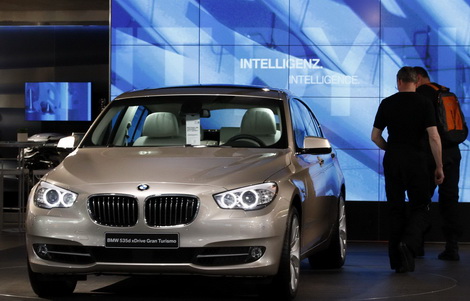BMW Q2 profit soars as Chinese demand
Updated: 2011-08-03 10:23
(Agencies)
|
|||||||||||
|
 A BMW five series is on display at the headquarters of the German luxury carmaker in Munich May 11, 2011.[Photo/Agencies] |
BMW tore through market expectations for second-quarter profits as more wealthy Chinese drove away with its revamped 5 Series saloon car, Reuter reported Tuesday.
The company reported an 83 percent jump in quarterly operating profit at its luxury car business, underpinned by surging sales of the 5 series and a 4.8 percentage point widening in its operating margin to 14.4 percent.
Although BMW is enjoying a golden year for profits, like Mercedes and Audi, the carmaker tempered expectations by predicting a return in the longer term to margins of 8-10 percent.
Bernstein analyst Max Warburton called the results "quite simply awesome" as BMW came in third only to luxury sports car makers Porsche and Ferrari in terms of sheer earnings power in the global auto industry.
"For an analyst that's covered BMW for 11 years it's amazing to see this level of earnings," he said in a note to clients. "At no point in the past would it have been imaginable that this company could make margins of this level."
Chinese demand for models like the top-of-the-line 7 Series, allowed BMW to charge higher prices and offer fewer margin-eroding incentives than ever before.
"What the market completely underestimates is the impact Chinese demand has on overall global pricing. Were it not for China, BMW would have to sweeten its leasing conditions to sell those additional 20,000 units of its 7 Series," UniCredit analyst Georg Stuerzer said.
The margin, the most closely followed metric for German luxury carmakers, exceeded the 12.8 percent forecast in a Reuters poll, even though analysts had already penciled in higher estimates after BMW raised its outlook last month.
Although BMW echoed Daimler in forecasting that sky-high growth rates would return to earth in emerging markets, this will not threaten their outlook as margins are supported largely by maintaining factory output near their current absolute limit.